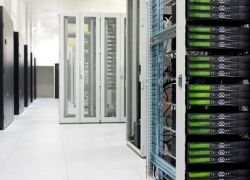How to effectively manage data center temperature
How to effectively manage data center temperature

Temperature management within the data center is one of the most important responsibilities for IT staff. If the temperature is too high, equipment could overheat and shut down. If it's too low, energy expenditure could increase and may cause electricity bills to skyrocket, resulting in a higher power usage effectiveness quotient and a negative impact on the bottom line in the long run.
So how do managers find that sweet spot of not too hot and not too cold? Here are a few tips for maintaining a just-right temperature in the data center:
Maintain rack hygiene
Ensuring rack hygiene is critical to increasing the effectiveness of cooling equipment throughout the facility. Hygiene refers to the way a server rack is designed and maintained. If, for example, the rack isn't designed with blanking panels to block air from circulating through the unused space at the front of the container, or experiences air leaks, efficient airflow may be compromised. In this situation, no matter how diligent managers are with checking the temperature and implementing changes to thermostats throughout the facility, energy could be lost in the short and the long term.
Poor rack hygiene can lead to a number of issues on the server room floor, including the re-circulation of hot exhaust air back into server intakes, according to Datacenter Dynamics contributor John Collins. If left unchecked, this hot exhaust can have devastating consequences for data centers, with the worst being possible server room blazes that begin with overheated equipment.
Take care of hot spots
Along with the preventive care of maintaining a proper rack hygiene, the detection and prevention of hot spots is a crucial part of keeping the data center cool. According to TechTarget contributor Robert Sullivan, hot spots can cause costly equipment failure and even more expensive system outages, so making sure temperature is evenly balanced throughout the facility is critical to maintaining server uptime.
Hot spots can also indicate where air is too dry, which can be caused by a lack of information about humidity in the data center. Maintaining temperature and humidity are, therefore, integral to the overall function of a computing facility.
"Hot spots have been attributed to a reduction in reliability and system outages, and have been associated with computer hardware equipment manufacturers threatening to void warranties or maintenance agreements," Sullivan wrote.
It's an important point to stress. As the cost of a data center outage continues to increase, companies can't afford to have a problem like this occur. If equipment is no longer covered under warranties, that could add a huge cost burden to the company, on top of the expense that may be incurred if disgruntled clients who experienced downtime decide to take their business elsewhere.
Tailor your monitoring solution
Data center managers need to make sure their monitoring solutions are working for them. Being able to view data center temperature from one central system - such as the kind provided by data center infrastructure management software - can allow IT managers to take necessary steps to cool down or warm up parts of the facility.
Monitoring solutions like the ones offered by Geist are scalable so they can grow with companies as they expand, whether that's outward into the server room with more tech equipment or inward by moving more applications to virtual servers. No matter the size or capability of the facility, sensors placed around the rack environment relay information to a central hub and allow managers to quickly implement solutions in order to positively impact efficiency. In other words, temperature monitoring offers advantages in effective data center management and therefore can reduce maintenance and operations costs.



